Printed Books & Bindings
Diversity and quality have been hallmarks of this collection, with works spanning Western book production from the earliest printed ephemera to important first editions from the twentieth century. The Morgan Library & Museum's holdings encompass a large number of high points in the history of printing, often exemplified by a lone surviving copy or a copy that is perfect in every way. Areas of exceptional strength include incunables, early children's books, fine bindings, and illustrated books.
The collection's strong base derives from the major acquisitions of Pierpont Morgan, who sought to establish in the United States a library worthy of the great European collections. It is rich in special and unique copies, first editions of classical authors, and works of notable printers, such as Jenson and Caxton. Among the highlights are three Gutenberg Bibles, a strong collection of works by Lord Byron, Charles Dickens, Edgar Allan Poe, John Ruskin, Mark Twain, Herman Melville, and William Morris, and classic early children's books. The Carter Burden Collection of American Literature, a major 1998 gift, strengthens the Morgan's twentieth-century holdings with authors such as Ted Hughes, Sylvia Plath, Vladimir Nabokov, Gertrude Stein, and Tennessee Williams.
There are many beautiful and important bindings in the Morgan, but the bindings collection comprises about a thousand volumes acquired primarily to document the development of bookbinding. It is among the finest collections of bindings in this hemisphere, equally strong in quantity and quality. Areas of particular distinction are English, French, and Italian bindings of the sixteenth through the early nineteenth centuries.
A practical illustration of Gilpin's day : representing the various effects on landscape scenery from morning till night, in thirty designs from nature / by the Rev. Wm. Gilpin ; with instructions in, and explanation of, the improved method of colouring,
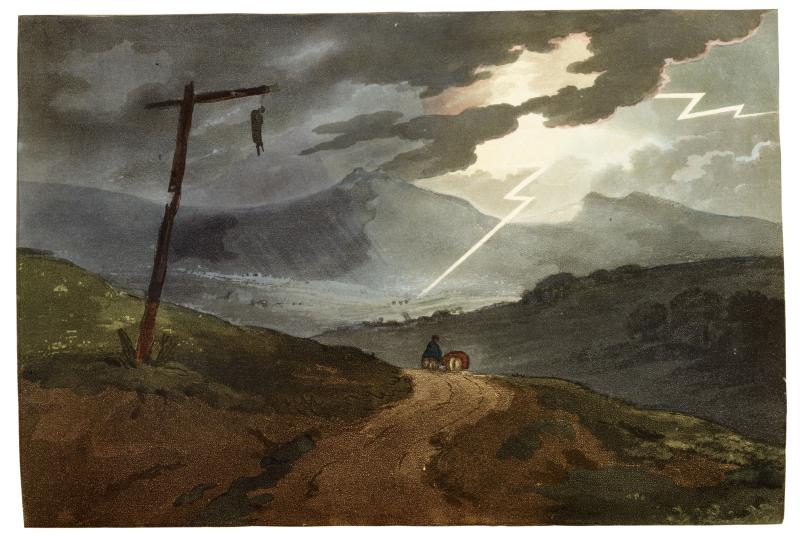
Scottish artist John Heaviside Clark added color to Gilpin's studies of the times of day, transforming a midday landscape into a sensational nocturnal scene with lightning. The heightened emotional resonance of this adaptation signals a shift toward the Romantic from Gilpin's more analytical and strictly visual eighteenth-century Picturesque.
"Printed by J. Hayes, Dartmouth Street, Westminster."
Illustrated with 30 hand colored aquatint landscapes by J.H. Clark after Gilpin.
Originally published by Edward Orme in 1811. The 1824 edition is a reissue of the plates with a new title page, published for 'the Proprietors'. Cf. Bicknell.
A tale of the house of the Wolfings and all the kindreds of the mark / written in prose and in verse by William Morris.
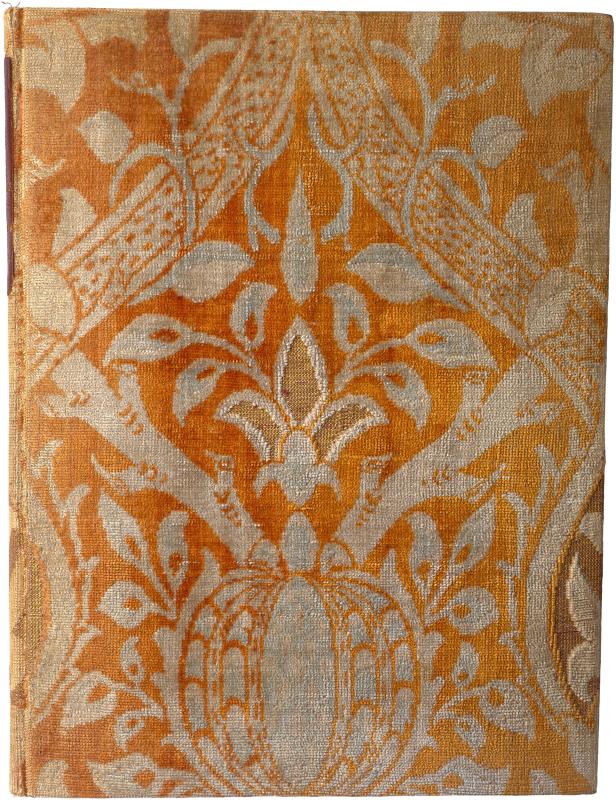
1st edition.
"Chiswick Press--Charles Whittingham and Co."--Colophon.
One of 100 large-paper copies (perhaps one of the 11 copies not for sale).
HIGH RESERVE; for bindings study only.
Manuscript of this work is housed in MA Dept. (MA 313)
Aesop's fables with his life : in English, French & Latin / the English by Tho. Philipott Esq. ; the French and Latin by Rob. Codrington ... ; illustrated with one hundred and twelve sculptures by Francis Barlow.

Includes 110 fables in French and Latin prose and English verse, the latter engraved below the illustrations.
1st ed.
Small-paper issue.
Added engraved t.p. dated 1665.
Signatures: [pi]1 b² ¹B-L² ²B-I² ³B-Z² (Q missigned as R 1,2) Aa-Zz² Aaa-Ppp² (3F2 missigned 3H2).
Quire B and pages C1v and C2r are in a different setting from the large-paper issue: the "B" of signature B2r is under the second "r" of "Overseer", the hyphen at the end of line 1 of C1v is sloped, and the first word of line 2 of C2r is "that."
Ordinary paper issue on foolscap paper.
Aesop's fables with his life : in English, French & Latin / the English by Tho. Philipott Esq. ; the French and Latin by Rob. Codrington ... ; illustrated with one hundred and twelve sculptures by Francis Barlow.

1st ed.
Added engraved t.p. dated 1665.
Includes 110 fables in French and Latin prose and English verse, the latter engraved below the illustrations.
Large-paper issue.
PML copy: the first two fables accompanied by parallel English text in cont. manuscript.
Quire B and pages C1v and C2r are in a different setting from small-paper version: the "B" of signature B2r is under "of", the hyphen at the end of line 1 of C1v is straight, and the first word of line 2 of C2r is "tbat" [sic].
Signatures: [pi]1 b² B-L² B-I² B-R² (Q² signed R²) R-3P² (3F2 signed 3H2).
Alberti Dureri clarissimi pictoris et geometrae de sym[m]etria partium in rectis formis hu[m]anorum corporum libri in Latinum conuersi.

Signatures: A-E⁶ F⁴ G-N⁶ O⁴.
Translation by Joachim Camerarius of books 1 and 2 of: Hierinn sind begriffen vier Bücher von menschlicher Proportion.
Imprint from colophon, which reads: Norimbergae excubatur opus aestate anni A Christo seruatore genito MDXXII ...
Apocalypsis Sanctis Johannis (Incipit: Conv[er]si ab ydolis p[er] perdicacione[m] b[eat]ti ioha[n]nis drusiana et ceteri).

A copy in Gutenberg Museum, Mainz has inscription dated 1463 and copy in Rylands Library, Manchester is in a Richenbach binding dated 1467.
Chancery folio.
Collation: [1-3¹⁶], 48 leaves.
PML has 12 leaves: 2, 6, 9, 16, 18, 21, 22, 26, 30, 33, 37, and 45.
PML leaves are trimmed to printed area, approximately 25.5 x 20 cm
Schreiber assumes Bennett copy was formerly owned by Rudolph Weigel in Leipzig, but Bennett acquired these twelve leaves in two separate purchases: leaves 2, 6, 9, 16, 26, 30, and 33 (28 Dec. 1896); leaves 18, 21, 22, 37, and 45 (17 April 1899) (see notes in Schreiber volume and item folder).
Schreiber ed. IV
Watermark: leaf 6. Shield of Metz. In PML leaves is Briquet 869 from Metz, dated 1448-60 (also found in Ryalands, Apocalypse IV; see notes in item file).
Watermark: leaf 16. Shield of Metz.
Watermark: leaf 30. Shield of Metz.
Hand decoration: All leaves are hand colored in orange, green, brown, and yellow. Annotations: most leaves with contemporary texts on verso in German.
Aurelii Augustini ep[iscop]i de civitate dei liber primus feliciter incipit.

Title from caption, leaf [3]/1r.
Imprint from colophon, leaf [31]/8v: Aurelii Augustini opus de civitate dei feliciter explicit: confectu[m] venetiis ab egregio [et] dilige[n]ti magistro Nicolao ie[n]son gallico: Petro moze[n]icho principe: Anno a nativitate d[omi]ni milesimo quadringe[n]tesimo septuagesimo quinto: sexto nonas octobris.
PML copy with variant colophon.
Printed in Jenson's types 2:84G and 4:110R.
Collation: [1-2⁸; 3-31¹⁰]: 306 leaves, leaves [1]/1, [2]/8, and [31]/9-10 blank.
Paper format: Chancery folio.
PML copy leaf dimensions: 28.6 x 19 cm.
PML copy on vellum.
Hand decoration: Illuminated frontispiece including St. Augustine in a study/garden, deer, fictive jewels, 2 cupids slaying a deer, and 2 women by a locked tower by Girolamo de Cremona (leaf [3]/17r), illuminated major initials, alternating red and blue initials with blue or red filigree penwork (possibly also by Girolamo), and alternating red and blue paragraph marks. Annotations: No marginal notations in text.
Biblia


Title from ISTC.
Printed in De Spira's type 1:110R.
Collation, part I: [1¹² 2-9¹⁰ 10¹²; 11¹⁰ 12-13⁸; 14-18¹⁰ 19⁸; 20-24¹⁰; 25¹⁰(+1); 26-30¹⁰ 31⁸(+1) 32¹⁰ 33⁶(+1)]: 325 leaves, leaves [1]/12, [19]/8, [27]/10, [28]/1 blank; part II: [34² 35-44¹⁰; 45-48¹⁰ 49⁸(+1) 50¹⁰; 51¹⁰ 52-53⁸; 54-56¹⁰ 57-60¹² 61⁸(+1) 62-63⁸; 64¹⁰ 65-66⁸]: 316 leaves.
Paper format: Royal folio.
Translated by Niccolò Malermi, with additions (including verse in praise of printed work naming printer) by Hieronymus Squarzaficus.
PML copy printed on vellum.
PML copy leaf dimensions: 39.5 x 27.8 cm.
PML copy missing 1 leaf: [19]/8 (blank).
Checklist title: Biblia Italica
Vol. I (PML 26983). Hand decoration: Contemporary Venetian illumination and rubrication, scene depicting the Creation of Eve in architectural framework with putto above holding a scroll: "sola virtute," and foliate bad-de-page decoration with armorial (leaf [2]/1r) and foliate illuminated initials by the Master of the Putti; alternating red and blue initials and paragraph marks, red rubrics, headlines, and Roman numeral foliation. The rubrics, headlines, and foliation are in the same hand in both volumes, although the initials are likely by different artists. Annotations: A few contemporary marginal notations in text, including 2 textual corrections in Psalms. A manuscript quire [*⁴] added between quires [27-28] with a table for the Psalms; in a similar hand and format to the tabula in vol. II, suggesting that both were produced at Camaldolite monastery. Contemporary manuscript alpha-numeric quire signatures.
Vol. II (PML 26984). Hand decoration: Contemporary Venetian illumination and rubrication, border with St. Jerome in the Wilderness (leaf [34]/1v) and scene depicting a judgement of Solomon, The Shooting of a Father's Corpse, set in an Italiate landscape, with a hanging scroll bearing the printed text, surrounded by an architectural border (leaf [35]/1v) and foliate initials by the Master of the Putti; another artist has collaborated on the historiated initials, with floral and penwork borders, in the style of Girolamo da Cremona; minor initials in blue on gold ground and in gold on red/blue/green ground with penwork decoration, alternating blue and gold paragraph marks, red rubrics, headlines, and Roman numeral foliation. The rubrics, headlines, and foliation are in the same hand in both volumes, although the initials are likely by different artists. Annotations: Contemporary manuscript numerical (beginning with 34) and alpha-numerical quire signatures. A manuscript quire [*⁸] added between quires [53-54] with a table for the New Testament, with colophon: "scripta in sancto Mathia de murano" (leaf [*]/8r), which might be a reference to Malermi's translation of the bible in that hermitage; illuminated with foliate border and "yhs" monogram in sunburst roundel (leaf [*]/1r). Manuscript tabula in both volumes are in same hand, suggesting that both were produced at Camaldolite monastery.
Book box, cuir-bouilli and cuir-ciselé technique.

Black leather box with brown leather liner; traces of pull-up tape[s?] contained in the box; stitching holes on one side, and remains of hempen cord; one side deeply impressed and cut with an image of the Holy Trinity enthroned with a wreath hanging behind, the other side impressed and cut the the Holy Monogram "yhs" in a sunburst; the lid inscribed on sides "O MATER.DEI | MEMENTO.MEI" between horizontal lines of foliage, the top of the lid cut with large letters "IHS", the sides cut in two vertical panels of hatched lines.
HIGH RESERVE; for bindings study only.
British and foreign animals [game] : a new game, moral, instructive and amusing : designed to allure the minds of youth to an acquaintance with the wonders of nature.

Dated from rules book (see Shefrin).
Imprint continues: "where may be had various games by Walker & Newton."
Nine numbered sections mounted on linen, with hand-colored images. Measures 49.3 x 39.5 cm. Plate mark: 48.2 x 39.2 cm.
Printed label on slipcase bears title: British and foreign animals; a new game, moral, instructive and amusing : designed to allure the minds of youth to an acquaintance with the wonders of nature / by William Darton.
William Darton, Jr. was in business from 1811 to 1830.
Engraved throughout.
Illustrations hand-colored.
Without a rules booklet.
Cirque / André Suarès ; eaux-fortes en couleurs et en noir de Georges Rouault.

Library's copy comprises 3 identical title pages (1 on heavier paper, possibly intended as a wrapper); [5] pages taken from Rouault's Cirque de l'étoile filante (Vollard, 1938); pages 7-[225] of Suarès's text; the whole volume illustrated with 20 wood engravings and 10 color aquatints, the latter present in multiple states in color and in black.
The illustration statement in this copy differs from other surviving maquettes and lacks any mention of the "dessins gravés sur bois," despite their presence in the first part of the volume.
Wood engravings after Rouault executed by Georges Aubert; presumably printed by Henri Jourde; aquatints printed by Roger Lacourière.
At least six other maquettes for Cirque survive, dated 1933 or 1936. The first maquette was created in 1931, according to Johnson, p. 165.
Printed chiefly on Rives.
A set of aquatints from this series were issued by Rouault in 1945.
Maquette for Cirque
Maquette for Cirque, which remained unpublished at Vollard's death.
Bonet, innovator in luxury bindings and among the best known of twentieth-century French art binders, executed a number of bindings for Cirque. All variants on a single decorative theme, a style Bonet called à decor rayonnant, they evoke the blaze of radiating circus lights.
The book and binding make this the most splendid livre d'artiste in the Morgan's collections, in its enormous scale, original artwork, and quality of its paper and presswork.
Rouault worked on the series of illustrations over many years. The resultant book, however, was never formally published. It is likely that most of the few surviving sets of pages of text and illustrations vary in makeup. The present copy contains a large number of proofs of the illustrations.
Confessionale. Add: Hermannus de Schildesche: Speculum sacerdotum.

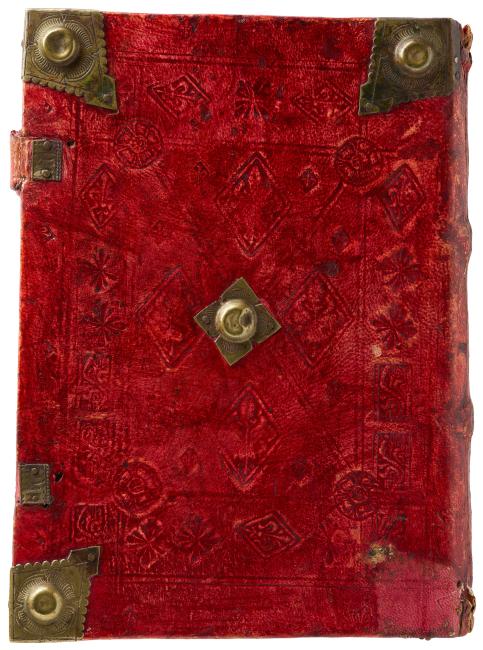
Checklist title: Interrogatorium sive Confessionale
Das ist die mapa mu[n]di un[d] alle land un[d] kungk reich wie sie ligend in der ga[n]sze welt.

Title in banderole at top of print.
Single woodcut leaf; signed, Hans Rüst and with his mark of a cross surmounted by a crescent; probably cut by him (from an unidentified design) in Augsburg, Germany in the last quarter of the 15th century (ca. 1475-1482). Sometimes cited as Hans Riist.
Sheet dimensions: 40 x 28.2 cm, trimmed, with slight losses to the left and right sides.
Printed on 1 sheet of chancery paper.
See Hassinger, R. Deutsche Weltkarten-Inkunabeln, 1927, who considers the St. Gall and Würzburg maps, by Hanns Preifmaler = Hanns Sporer to be slightly later copies of this (Morgan-Hans Rüst) map. Rüst was a cartographer and woodcutter who worked at Augsburg in 1472-1497. A single woodcut leaf "The Death" by him is in the Print collection at Munich. For bibliography see note laid in with map.
A slightly later, nearly identical map was produced by Hanns Priefmaler (i.e. Hans Sporer), at the National Gallery of Art, 1943.3 645, similarly previously glued inside the front cover of a book.
When purchased this map was pasted on the inner front cover of Strabo, Geography (Venice: Vindelin de Spira, 1472), PML 19291/ChL 730; this cover, containing the map, has since been removed from the volume and catalogued separately.
Das ist die mapa mundi und alle land und kungkreich wie sie ligend in der gansze welt
Woodcut hand colored.
De historia stirpium commentarii insignes, maximis impensis et vigilliis elaborati, adjectis earundem vivis plusquam quingentis imaginibus ...
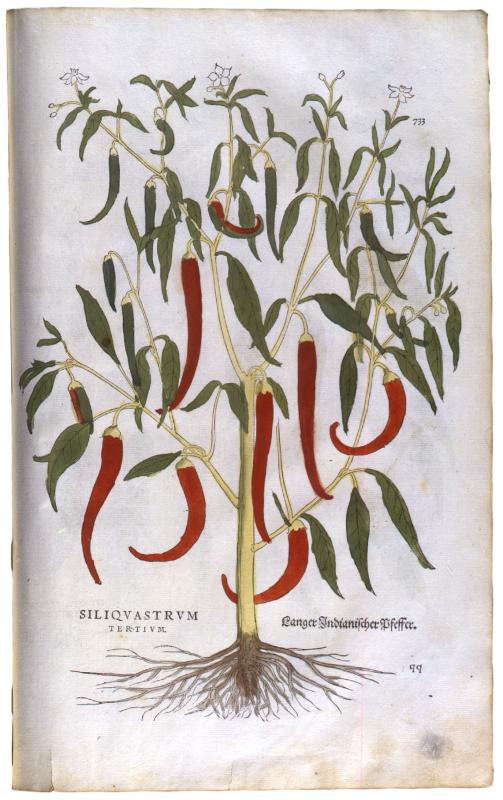
Subtitle: Regiones peregrinas pleri[que], alij alias, sumptu ingenti, studio indefesso, nec sine discrimine uitae nonnunquam, adierunt, ut simplicium materiae cognoscendae facultatem compararent sibi : eam tibi materiam uniuersam summo & impensarum & temporis compendio, procul discrimine omni, tanquam in uiuo iucundissimo[que] uiridario, magna cum uoluptate, hinc cognoscere licebit.
Cuts by V.R. Specklin from drawings by H. Füllmaurer and A. Meyer.
With ports. of the author, the designers, and the engraver (leaf fff5r). Probably the first book which contains not only the names, but also the ports. of its illustrators. Cf. Becher; cf. Klebs. A catalogue of early herbals. 1925, no. 72.
Printer's device with motto "Palma Ising" on title page and final blank verso.
Der Ritter vom Turn : von den Exempel[n] der gotsforcht v[o]n erberkeit.
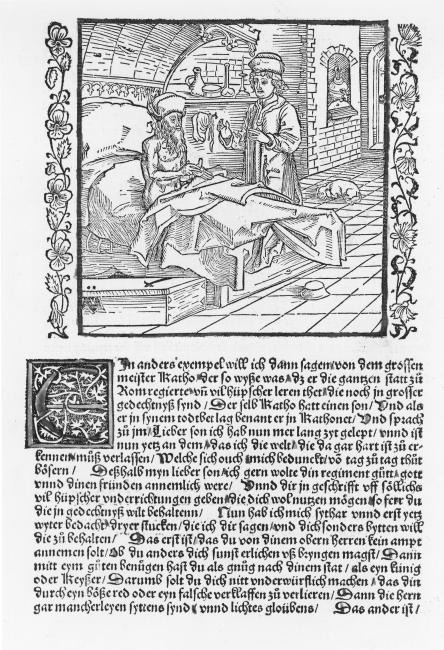
Title from half-title page, leaf A1r.
Imprint from colophon, leaf M5v: Der Spiegel der Tugent und Ersamkeyt/ durch den hochberümten Ritter vo[n] Thurn mitt schönen unnd kostlichen hystorien und Exe[m]pel/ zů underwysung syner kind/ in Frantzosischer sprach begriffen/ und durch den Edlen fürnemen un[d] Strengen/ hern Marquart vom Steyn Ritter/ und Landtuogt zů Montellicart/ in tütsch transferiert unnd gezogenn/ Zů Basel in dem jor nach Christi geburt .M.cccc.xciii. jor gedruckt durch Micheln Furter endet sich seliklich Amen. 1493. Nüt on ursach [in scroll]. IB.
Printed in Furter's types 3:180G and 4*:94G.
Initials IB at end of colophon for Johann Bergmann.
Signatures: A⁸ B-M⁶: 74 leaves, leaf M6 blank.
Paper format: Chancery folio.
1 column, 44 lines. Printed initials.
Translated by Marquart von Stein.
46 woodcuts from 45 blocks (title page illustration repeats).
PML copy leaf dimensions: 28.3 x 19 cm.
PML copy missing 1 leaf: E6, replaced in facsimile.
Der Ritter vom Turm
Hand decoration: Red underlining, highlighting of woodcuts, and capital strokes. Annotations: No marginal notations in text. Mid-16th century German notes, faded/partially illegible (leaf M6r).
Dialogo dei due massimi sistemi del mondo.

Engraved (added) title, t.p., letter to the Grand Duke, and note to the reader, 6ff.; text, 458 numbered pages; errata, 1 fol.; table, 15 ff; last fol., blank.
First ed.
Quarto; *[superscript]6 A-Z8 Aa-Ee[superscript]8 Ff[superscript]6 Gg-Kk[superscript]4; 252 leaves wanting folio *[superscript]6 (a blank?), with an engraved title and numberous illustrations.
El Ingenioso hidalgo Don Quixote de la Mancha ; / compuesto por Miguel de Cervántes Saavedra
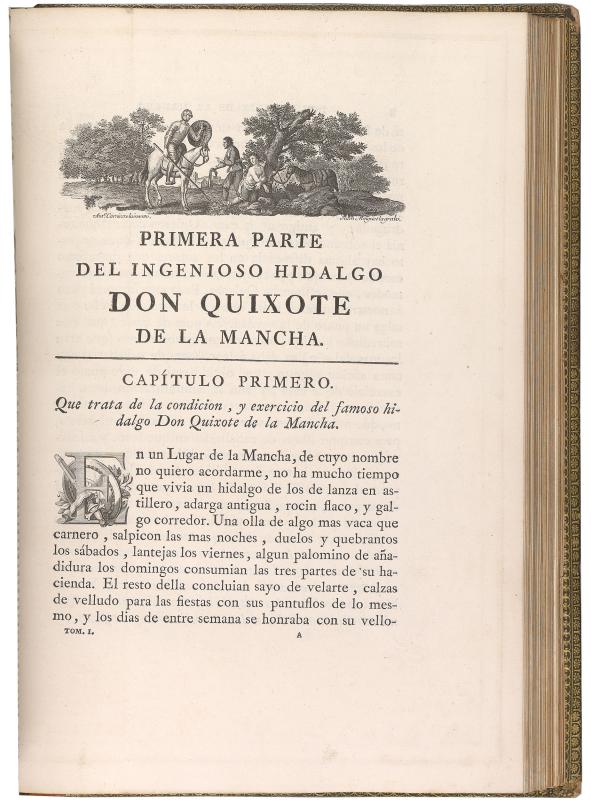
Essai sur l'architecture / par le P. Laugier ...
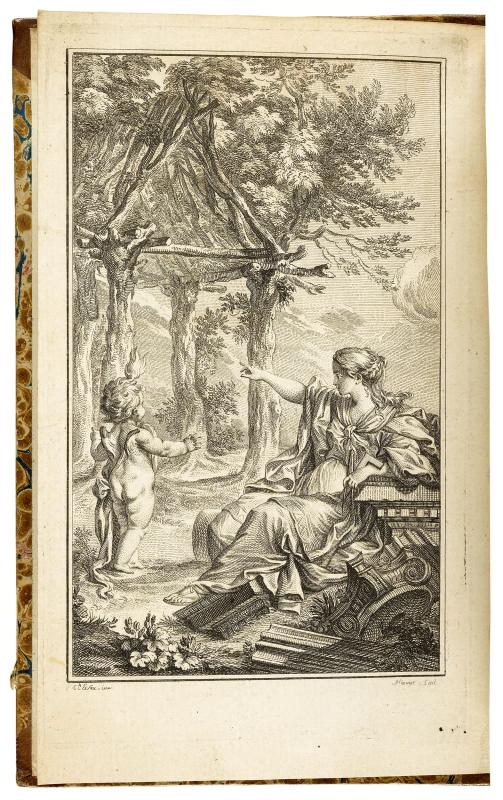
A master of Rococo illustration, Eisen understood perfectly the author's arguments against Rococo ornament in architecture—a capricious stylistic aberration that should be corrected by a return to nature. A winsome goddess of architecture reclines against the ruins of the classical orders and gestures toward a more truthful and authentic structure, a rustic cabin framed by living trees. Laugier applied some of the same reasoning to garden design in the last chapter of this influential treatise. As much as he admired the work of Le Nôtre in Versailles, he had to regret the relentless insistence on symmetry in that type of formal garden and preferred instead the elegant simplicity of the Chinese style, which had been described by missionaries in their reports on oriental customs and culture.
Title in red and black; vignette; head- and tail-pieces; initials.
Illustrated with engraved frontispiece by Jacques Aliamet after Charles Eisen and 8 folded plates of architectural plans engraved by Fonbonne.
Privilege given to N.B. Duchesne, Paris.
"Fautes à corriger"--p. [4] of second count.
"Dictionnaire des termes de l'architecture"--p. 277-306.
"Autres livres d'architecture qui se vendent chez Duchesne, rue St. Jacques, au Temple du Goût"--p. [4] of last count.
Includes index.
Fire!! a quarterly devoted to the younger Negro artists / premier edition edited by Wallace Thurman in association with Langston Hughes [and others].
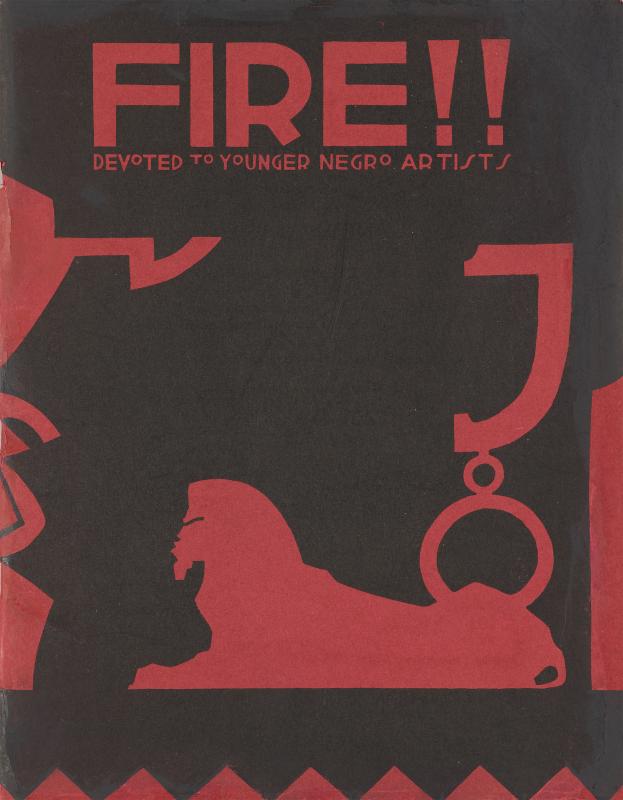
Cover title: Fire!! devoted to younger Negro artists.
V. 1, no. 1, Nov. 1926.
No more published.
Edited by Wallace Thurman, in association with Langston Hughes, Zora Neale Hurston, et al.
Featuring contributions by Wallace Thurman, Langston Hughes, Zora Neale Hurston, Gwendolyn Bennet, Richard Bruce, Arthur Huff Fauset, Countee Cullen, and others, with illustrations by Aaron Douglas and Richard Bruce.
"Printed by Joseph Leventhal, New York City"--Colophon.
Library's copy housed in black cloth clamshell box.
Frankenstein, or, The modern Prometheus.

The seed of Mary Shelley's masterpiece came to her in a dream of a young scientist patching together a new being from dead bodies. This copy preserves her autograph changes to the first edition, making the volume an important witness to her creative process. It is also a memorial to grief. After the drowning of her husband, the poet Percy Bysshe Shelley, in July 1822, Mary Shelley turned to everyone she could for sympathy, and gave this copy of Frankenstein to a woman now known only as Mrs. Thomas, who describes its writer as "helpless, Pennyless, and broken hearted."
First ed.
Heures a lusaige de Ro[m]me : sans riens req[ue]rir.

Printed on vellum.
With four additional leaves containing extra prayers in manuscript, a coat of arms (defaced), and two miniatures, a Crucifixion and a scene depicting the Sacred Bleeding Host of Dijon.
Horae: ad usum Romanum.

Title from ISTC.
Colophon, leaf I8v: Ces presentes heures ont este acheueez le deuziesme iour de septembre .M.cccc. quatrevingtz et cinq [et] faictes i[m]p[ri]mer p[er] a[n]thoine verard libraire demoura[n]t a paris a lymaige sainte iehan levangeliste sur le pont n[ot]re dame ou au palaiz au p[ri]mier pylier devant la chapelle ou on cha[n]te la messe messeigneurs les p[er]side[n]s.
Printing attributed to Jean Du Pré in GW. Otto Schäfer catalogue attributed to Jean Le Rouge (in Chablis or Troyes). These sources mistakenly transcribe the imprint date in the colophon as 12 September.
Printed in De Pré's types 18:71G and 18*:71G.
Signatures: [1-2⁸]; a-d⁸; AA, B-H⁸; [I]⁸: 120 leaves.
44 woodcuts, with repetitions.
For typographical evidence supporting the attribution to Jean Le Rouge see Monceaux, Les Le Rouge de Chablis, pp. 116-119.
For an account of the woodcuts and a reassessment of the Jean Du Pré attribution see Tenschert, ed., Horae B.M.V., vol. 4, p. 1392.
PML copy on vellum.
PML copy leaf dimensions: 12 x 8.4 cm.
Hand decoration: Contemporary French rubrication, alternating red and blue initials and underlining. Inscriptions: Important feasts added to calendar in red. Contemporary prayer (leaf H8v). Bird drawn into the woodcut of St. Apollonia (leaf G8v).
Horae: ad usum Romanum.

Title from ISTC.
Imprint from colophon, leaf m4v: Ces presentes heures a lusaige de Romme furent achevees le .xxviii. iour de Juing Lan mil cinq cens. pour Simo[n] vostre Libraire: demoura[n]t a Paris en la rue neuue nostre dame a lenseigne sainct Jehan levangeliste.
Printed in Pigouchet's types 1:98G, 2:64G, and 3:80G. Pigouchet's printer's mark, leaf a1r.
Signatures: a-l⁸ m⁴: 92 leaves.
Paper format: Chancery octavo.
Almanac for years 1497-1520, leaf a1v.
Signed r on first leaf of each quire for Roman use.
Woodcuts and metalcuts.
PML copy leaf dimensions: 14.4 x 9.4 cm.
PML copy missing 2 leaves: d4.5.
Hand decoration: Contemporary rubrication, alternating red and blue intitials. Annotations: No notations in text.
I quattro libri dell'architettura / di Andrea Palladio ; ne'quali, dopo un breue trattato de'cinque ordini, & di quelli auertimenti, che sono piu necessarij nel fabricare ...

The architect Andrea Palladio's literary masterwork, the treatise I quattro libri dell'architettura, begun in 1555, profoundly influenced Western architecture.
This illustration presents a plan and an elevation of Palladio's Villa La Rotonda, just outside Vicenza. The design is for a completely symmetrical building with a square plan around a central circular hall with a dome. Each of the four facades has a portico.
1st ed. of the four books in 1 vol.
Books 2-4 have separate t.p.
Mellon no.: L 44.75.
Signatures: vol. 1: A² B-I⁴; vol. 2: 2A-2K⁴; vol. 3: 3A-3F⁴; vol. 4: 4A-4R⁴ (2K4 and 4R4 blanks); 4F1 missigned 4E1.
Illustrium maioris Britanniae scriptorum : hoc est, Angliae, Cambriae, ac Scotiae summariu[m] ... / autore Ioanne Balaeo ...
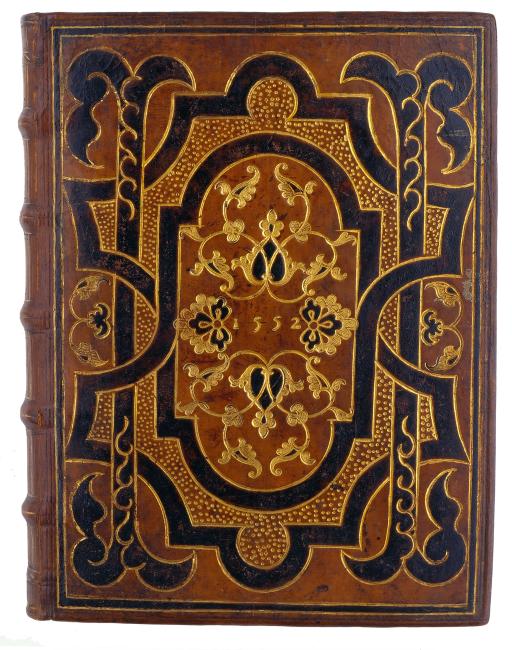
Imprint from colophon, folio 248 recto; actually printed at Wesel by Derick van der Straten (Theodoricus Plateanus), whose imprint appears on the t.p. of a variant issue, cf. STC 1296.
Ruled in red.
In Congress, July 4, 1776. A declaration by the representatives of the United States of America : in general Congress assembled.

First state (of 2); Goff's Imprint a.
Declaration of independence
Le fontane di Roma nelle piazze e luoghi publici della città : con li loro prospetti, come sono al presente / disegnate et intagliate da Gio: Battista Falda ; date in luce con direttione e cura da Gio: Giacomo de Rossi ...

In 1661 Gian Lorenzo Bernini altered the gardens of the Villa d'Este at Tivoli to create a tumultuous cascade of water erupting through the garden wall and crashing down onto an axis of rugged boulders. Acclaimed as the most spectacular artificial waterfall of its century, it was a precursor of Sublime extremes in landscape architecture.
"Concesso l'anno 1691 il di 20 ottobre"--T.p.
Mellon no.: T177.35.
Title of pt. 2 reads: Le fontane delle ville di Frascati, nel Tusculano, con li loro prospetti ... disegnate, et intagliate da Gio: Battista Falda ...
Title of pt. 3 reads: Le fontane ne' palazzi e ne' giardini di Roma, con li loro prospetti et ornamenti, disegnate ed intagliate da Gio. Francesco Venturini...
Title of pt. 4 reads: Le fontane del giardino Estense in Tivoli, con li loro prospetti, e vedute della cascata del fiume Aniene, disegnate, et intagliate da Gio: Francesco Venturini ...
Leaves of grass.
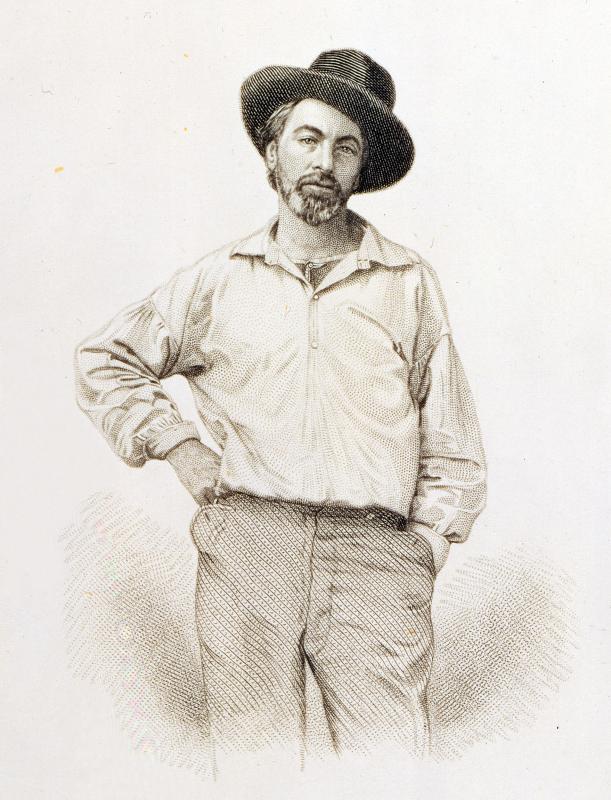
First edition, second issue.
Second state of copyright page and page iv ("cities and").
Author's name in copyright notice on verso of title page.
Portrait frontispiece printed on thin paper measuring 20 x 12.5 cm. (7 7/8 x 4 7/8"). pasted onto leaf of text paper, without embossing.
With 8 pages of advertisements and reviews at end (see Myerson, p. 19.
Les jardins : poëme / par Jacques Delille.

First published in 1782, the Abbé Delille's poem extolling the landscape garden went through many editions, six of which are now at the Morgan. The augmented edition of 1801 acquired over one thousand new lines and a new set of Romantic illustrations by Nicolas André Monsiaux. This vision of Alexander Pope in his garden, weeping on the monument to his late mother, faces verses describing the visit of the dying poet to his mother's tomb: "Approach, contemplate this pious monument where wept in silence a faithful son."
Plates engraved by Prevost, Choffard and Saint Aubin after Nicolas André Monsiaux.
"Notes du poëme Les jardins": p. [157]-216.
Half title: Jardins, ou, L'art d'embellir les paysages
Les roses / par P.J. Redouté, peintre de fleurs ... avec le texte par Cl. Ant. Thory ...

1st ed.
Estate of Mrs. J.P. Morgan.
Full-page stipple engravings, partially printed in color and finished by hand, including frontispiece (wreath of roses engraved by Charlin, with Greek inscription printed in gold). Engravers include Langlois (59), Chapuy (41) and Bessin (or Bessa) (22). Port. of Redouté by C.S. Pradier after Gerard, 1811.
Library has one of 5 copies with plates in two states, plain (on brown paper) and colored.
Library has original watercolors (signed) on vellum for Rosa rubrifolia (vol. 1, opp. p. 32) and Rosa pimpinelli-folia inermis (vol. 3, opp. p. 24).
Originally issued in 30 pts., Mar. 22, 1817-Mar. 6, 1824.
Vol. 1: 156, [2] p., [58] leaves of plates; v. 2: 122, [2] p., [59] leaves of plates; v. 3: 125, [2] p., [54] leaves of plates.
Libro di Benedetto Bordone nel qual si ragiona de tutte l'isole del mondo ...
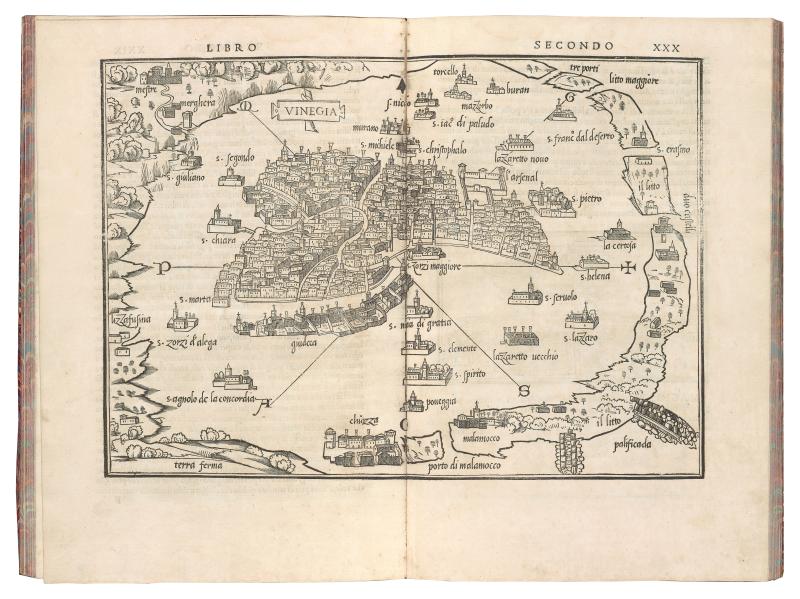
Originally intended as a guide for sailors, Bordone's Isolario describes the important islands and ports throughout the Mediterranean and in other parts of the world, also touching on their culture and history. Some of the illustrations are among the earliest printed maps of the regions depicted. The book also includes new discoveries, such as the connection between North and South America. The polymath Bordone—a miniaturist, astrologer, engraver, and cartographer—helped to establish island books as a popular new genre in Italy, and many were produced in Venice.
This marvelously detailed map of Venice (Vinegia) provides an excellent perspective of the lagoon and surrounding islands, detailing the major canals and landmarks in and around the city.
Later editions have title: Isolario.
Publishing information taken from colophon.
Title in red and black.
Light in August / William Faulkner.
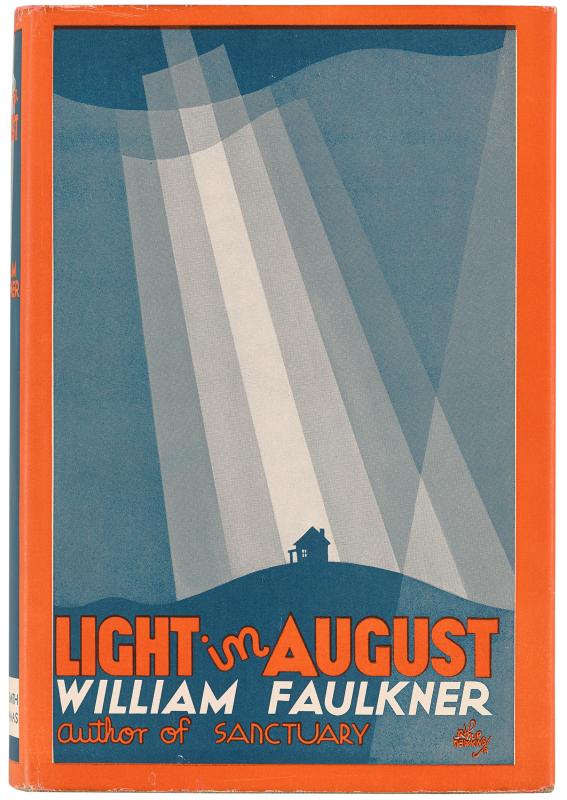
"New York, October 1932, First printing"--T.p. verso.
Inscribed by the author on front free endpaper: To Max Wilk / William Faulkner / Hollywood / 10 May 1943.
Bookseller's note: **dj.
In drop-down box.
Lustige Geschichten und drollige Bilder : mit 15 schön kolorirten Tafeln : für Kinder von 3-6 Jahren.

First edition of Heinrich Hoffmann's Struwwelpeter poems and pictures. Struwwelpeter appears on leaf 15.
Cover title.
First leaf blank.
Printed on one side of the leaf only.
Laid in: photocopy of introduction to 1926 pub. of manuscript, and H.P. Kraus's notes.
Manuscript account book : [Florence], [1517-1551].

A description of the manuscript by the accounting historian Richard A., Goldthwaite, 5 December 2004, is in the department's binding file.
Light brown goatskin, with overlapping edges in a wallet style, blind-tooled using a variety of knotwork and arabesque tools, with goatskin appliqués employing blue and pink stitching and silk ribbon interlace. As is customary with such bindings, an extended fore edge flap wraps around from the lower cover and closes over the upper. The two grommets in the flap served to channel fabric or leather ties that secured the flap.
Account books, customarily bound in this fashion for centuries to permit their use in the open air and in any weather, were subjected to very hard use. Consequently their survival rate is poor. Sumptuous examples such as the present one, however, constituted luxury versions used by the wealthiest merchants and bankers of Renaissance Florence, and the fresh state of its preservation is nothing short of extraordinary. The manuscript of Lanfredino's "White Confidential Book" is highly important to accounting historians.
Missale Romanum, ex decreto sacrosancti concilii Tridentini restitutum, Pii V. Pont. Max. iussu editum.

Printed in red and black throughout, mostly in two columns with woodcut illustrations; one full-page woodcut by Bernard Salomon facing the Canon, a large woodcut of SS. Peter and Paul on t.p. and 256 woodcuts, throughout.
HIGH RESERVE; for bindings study only.
Mr. William Shakespeares comedies, histories & tragedies : published according to the true originall copies.

Colophon: Printed at the Charges of W. Jaggard, Ed. Blount, I. Smithweeke, and W. Aspley, 1623.
Editors' dedication signed: Iohn Heminge. Henry Condell.
With an engraved title-page portrait of the author signed: "Martin· Droeshout: sculpsit· London." State 1 has no shadow on the ruff under the hair; state 2 has a shadow.
"The life and death of King Iohn" begins new pagination on leaf a1r; "The tragedy of Coriolanus" begins new pagination on leaf 2a1r.
Title page is an insert.
For details on the printing of this item see Charleton Hinman, "The printing and proof-reading of the First Folio of Shakespeare" (Oxford, 1963).
Entered to Blount and I. Jaggard 8 November [1623] in Stationers' Company register.
Numerous errors in pagination.
PML copy is third issue, with cancelled leaf "gg3" with end of Romeo and Juliet and first page of Troilus and Cressida, along with cancel leaf with the Prologue (recto) to Troilus and reprint of the first page (verso), bound before Coriolanus (see Blayney, p. 24).
PML copy with engraving in state 2. Title page leaf remargined (from another copy?, by Toovey, ca. 1887).
Mr. VVilliam Shakespeares comedies, histories, & tragedies
Watermark: page 124 of Loves Labor Lost. Small crown. Variant 1) over letters "ED".
Watermark: page 124 of Julius Caesar. Small crown. Variant 1) with letters "LLV ".
Watermark: page 252. Small crown. Variant 2) fleur-de-lis in band of crown.
Watermark: page 309 of Julius Caesar. Small crown. Variant 3) with LLV(?) in base of crown.
Watermark: Small coat of arms. [Unknown page.]
Oriental scenery : twenty-four views in Hindoostan ...
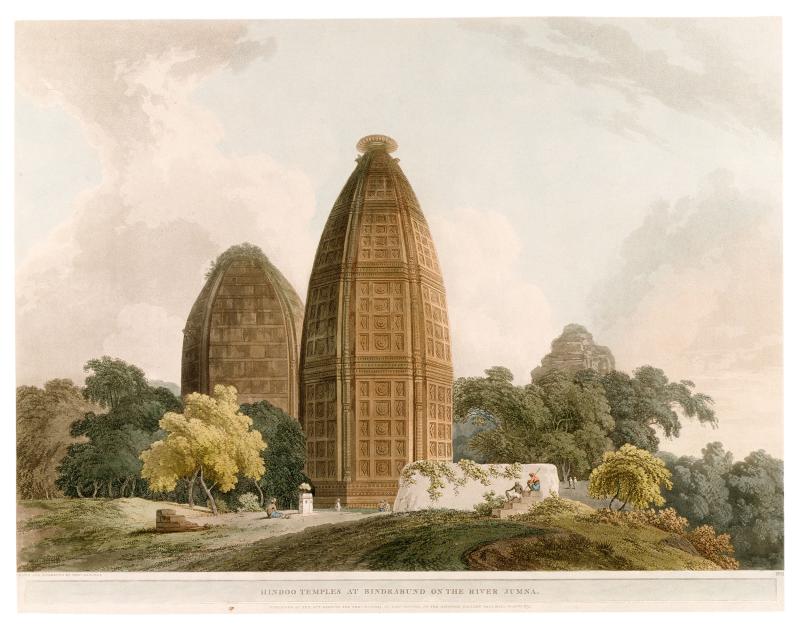
Plates: 7 vols. (150 colored aquatints) measure 82 cm
Text: PML 75754-6, parts 4-6 together in PML 75764.
Plans, elevations, sections, and perspective views of the gardens and buildings at Kew, in Surry ... / by William Chambers ...

In 1757 William Chambers, the only architect in England to have directly observed East Asian architecture, began to design new gardens at Kew with artificial ruins and exotic structures. His famous pagoda represents the Chinese style on which he published two treatises. Chambers's discussion of Chinese gardens, some of which he classified as Romantic, promoted the idea of provoking powerful emotional responses through selected effects in landscape design: "the spectator is to be amused . . . his curiosity excited, and his mind agitated by a great variety of opposite passions." His work is the basis for the Continental European concept of the jardin anglo-chinois.
Architectural designs by Chambers, William Kent ... and John ...
Figures furnished by Giovanni B. Cipriani (1727-1785).
Views drawn by John Joshua Kirby (1716-1774), Thomas Sandby (1721-1798) and T. Marlow and William Marlow (1740-1813).
Plates engraved by F. Patton, Tobias Müller, Edward Rooker, James Basire, James Noural, W. Wollett, Paul Sandby, Thomas Major and Charles Grignion.
Uncut copy.
Watermark: on page with Theater of Augusta. Fleur-de-lis in shield, surmounted by crown, over "4" and letters "LVG", (Strasbourg lily).
Poems / by Dante Gabriel Rossetti.
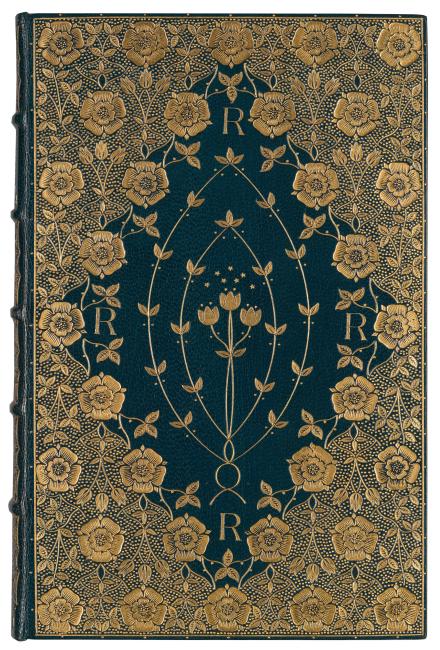
First ed. Cf. Rossetti, W.M. in the Bibliographer, v. 1, 1902, p. 428. P. 275 misnumbered 27.
"London: Strangeways and Walden, Printers ..."--P. [283].
Last page blank.
Thomas James Cobden-Sanderson, a lawyer by profession, took up binding in 1883 at the urging of Jane Burden Morris, Pre-Raphaelite muse and William Morris's wife. Janey's instincts were on the mark: Cobden-Sanderson proved to be not just a talented amateur but a highly skilled designer and gilder. His bindings set the mark for designer bookbinders for decades, his tools and layouts revolutionizing the aesthetic of fine bookbinding. This is one of his most attractive, balanced, and accomplished bindings.
Poems on various subjects, religious and moral / by Phillis Wheatley, negro servant to Mr. John Wheatley, of Boston, in New England.
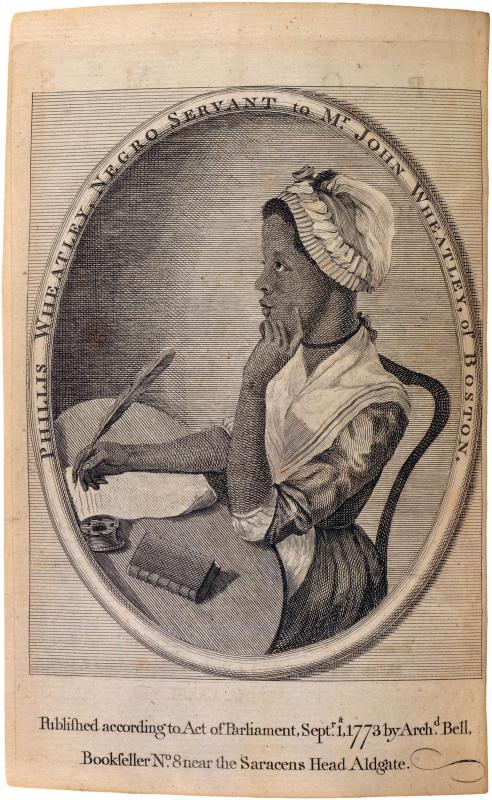
1st issue. P. 121, stanza IX ends with a comma; p. 122, stanza XII, line 2 has no comma.
Signatures: [A]4 B-Q4.
Gatherings B-N have horizontal chain lines; gatherings [A], O-Q have vertical.
Includes dedication, pref., letter by John Wheatley, and statement signed by Thomas Hutc[h]inson et al.; advertisement, p. [128], concludes with a citation to the Gospel of Luke.
Author's signature on verso of t.p.
Salome : a tragedy in one act / translated from the French of Oscar Wilde ; pictured by Aubrey Beardsley.

1st English ed., 1st issue.
"Of this edition 500 copies have been printed for England"--P. [4].
Illustrated title page and list of illustrations.
Illustrations engraved by Carl Hentschel.
Scene e machine preparate alle Nozze di Teti Balletto Reale / representato nella sala del piccolo Borbone et da Giacomo Torelli inventore dedicate all Eminentissimo prencipe Cardinal Mazzarino.

Engraved illustrated t.p., with title in French following the Italian; text in Italian and French.
Title-page and plates engraved by I. Silvestre after drawings by F. Francart of Torelli's designs.
Decorations et machines aprestées aux Nopces de Tetis, Ballet Royal
La Finta Pazza, the first Italian opera performed in France (in 1645), was a brilliant success for the Italian stage designer and engineer Giacomo Torelli, who followed up with a prequel, the ballet Nozze di Teti, starring Louis XIV in the part of Apollo. For these two commemorative publications, Torelli commissioned the eminent engravers Nicolas Cochin and Israël Silvestre to engrave large double-folding plates after his designs for sets, which had astounded audiences with tricks of perspective and ingenious mechanical devices. This copy is in an elaborate armorial binding, indicating that it once belonged to Henri-Jules de Bourbon-Condé, son of Louis II of Bourbon, "Le Grand Condé," and proprietor of the magnificent library at Chantilly.
Suite of plates for Collection complète des oeuvres de J.J. Rousseau [print]
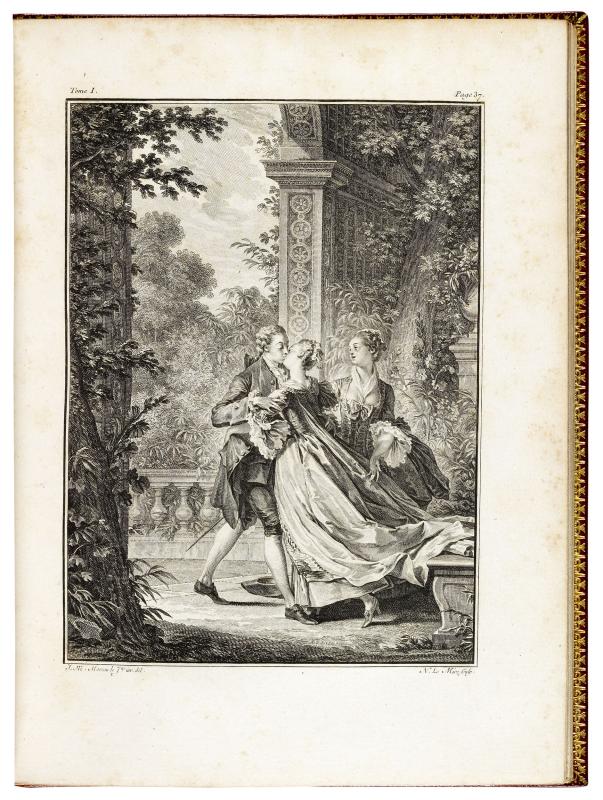
Julie, accompanied by her cousin, grants a first kiss to her lover in a bosquet, or bower. This memorable scene was a favorite of the novel's illustrators, beginning with Hubert François Gravelot, who received detailed instructions from Rousseau on how to achieve just the right combination of innocence and sensuality. And yet his composition seems staid in comparison to this version by Moreau le Jeune, who admired Rousseau's works and had studied them closely. Moreau understood what kind of bower the author had in mind, not the neatly trimmed trellis imagined by Gravelot but rather this grand arch overgrown by trees, shrubbery, and flowers.
Engravings after Moreau, Le Barbier and de La Tour by St. Aubin, Choffard, Duclos, Duflos, N. de Launay, R. Delaunay, Le Mire, Leveau, Martini, Simonet, Dambrun, Halbou, Ingouf, Romanet and Trière.
The Bible : that is, the Holy Scriptures conteined in the Old and New Testament ...

"Another edition of Tomson's Genevan Bible of 1587, with the annotations of F. Junius added. Without Apocrypha." Cf. BLC, v. 28, p. 373.
"The order of time ... ": verso of leaf preceding Revelation.
Added t.p. and t.p. to N.T. have McKerrow & Ferguson border Appendix 6, Holland copy of no. 230.
Double columns, with commentary in margins.
Imprint correction from STC (2nd ed.), 2179.
Includes Downame's concordance, n.d.
Library copy perfect, has the blank leaf after second leaf 127 (end of Prophets).
N.T. has separate t.p.: The New Testament of Our Lord Jesus Christ / translated out of the Greeke by Theod. Beza, with briefe summaries and expositions upon the hard places by the said authour, Ioac. Camer. and P. Loseler. Villerius ; Englished by L. Tomson ; together with the annotations of Fr. Iunius upon the Revelation of S. Iohn. Imprinted at London : by the deputies of Christopher Barker ..., 1599.
Printed for English use in the Low countries.
Inscription on front pastedown: "Anne Cornwaleys Wrought me / now shee is called Anne Leigh".
The Holy Bible ...
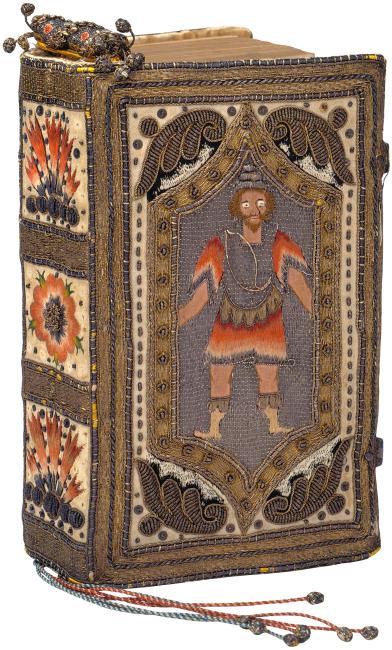
The holy Bible.

HIGH RESERVE; for bindings study only.
Bartlett is among the best-documented binders of the Restoration era. He originally worked in London but migrated to Oxford after the Great Fire of 1666. He worked at Oxford until his retirement, ca. 1690, and died in his native Watlington in 1712.
One of Bartlett's finest works is this Bible, bound using many of his documented tools in his characteristic cottage-roof pattern. The interesting fore edge painting, visible when the leaves are fanned, is a flower-wreathed portrait of a young woman. She is very likely the book's first owner, who signed her name on the title page as Mary Alston and as Mary Clayton, with the date 1678. The change in name in the inscription makes one suspect that this binding was a marriage present.
The story of Sigurd the Volsung and the fall of the Niblungs / by William Morris.

Last 6 p. are publisher's advertisements, integral with last gathering.
The swan of elegance : a new game designed for the instruction and amusement of youth.

Issued with pamphlet: Rules and directions for playing The Swan of elegance, a new moral game... London: Printed [by H. Bryer] for J. Harris, 1815.
Library's copy now unfolded and matted (PML 85346.1); pamphlet (PML 85346.2) and case (PML 85346.3) stored separately in same box.
Game consists of a large hand-colored engraving mounted as panels on linen. It depicts a swan wrapped in a wide ribbon on which are 31 numbered spaces, each with a scene showing children engaged in typical activities. The game was to be played with a spinner and counters (not supplied by the publisher).
The tale of Peter Rabbit / by Beatrix Potter.
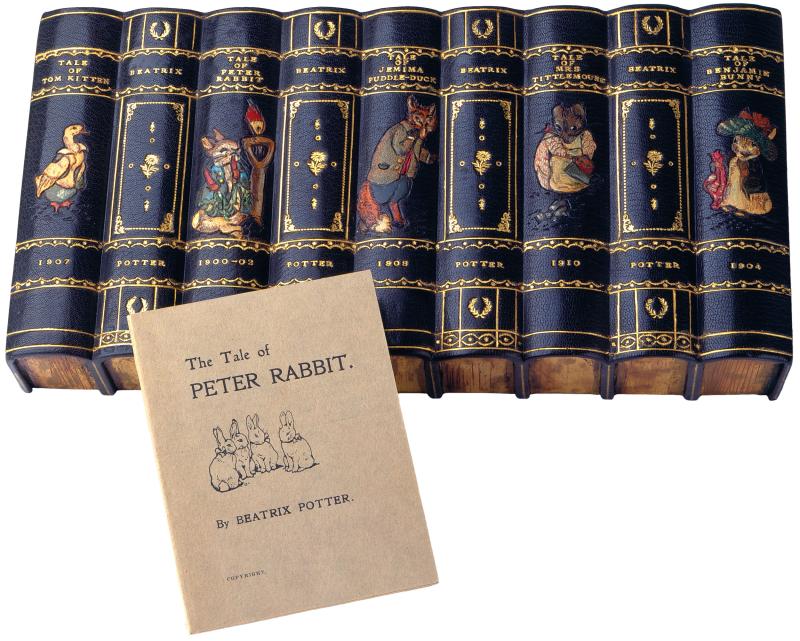
First edition, privately printed. 250 copies issued December, 1901.
Plates included in pagination.
Frontispiece in color; other plates in black and white.
"London: Strangeways, printers." - p. [86].
Shelved in Beatrix Potter case (PML 87356).
The works / of Geoffrey Chaucer ; now newly imprinted.

T.p. and 1st text page within woodcut borders; ornamental initials and marginal decorations; sidenotes in red.
"...edited by F.S. Ellis; ...pictures designed by Sir Edward Burne-Jones" -- colophon.
The yellow wall paper / by Charlotte Perkins Stetson.
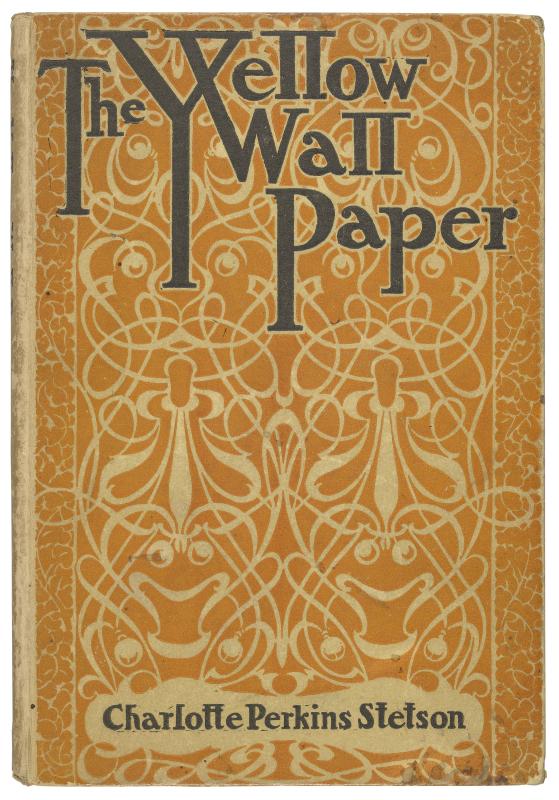
1st ed.
Verso of t.p.: "Rockwell & Churchill Press, Boston, U.S.A."
Reprinted from The New England Magazine of January, 1892.
P. [6]: "The cover design is by Mr. E.B. Bird."
Three stories & ten poems / Ernest Hemingway.

This copy of Hemingway's first book claims singularity by its provenance: it was this volume that Hemingway sent to Edmund Wilson in November 1923, asking for a review in The Dial. The book had appeared in Paris, where Hemingway was already well known in expatriate circles but had made little noise in the United States. Wilson read it immediately and responded warmly with a review that helped to make the young writer's reputation.
Edition of 300 copies.
"Published by Robert McAlmon at the Contact Publishing Co., Paris ..."--Cf. Hanneman.
Inscribed by the author on front free endpaper: To Edmund Wilson from Ernest Hemingway. Toronto, 1923.
Bookseller's note: **to Wilson 1/300 wr.
In slipcase.
Thus endeth thys noble and joyous book entytled le morte Darthur.
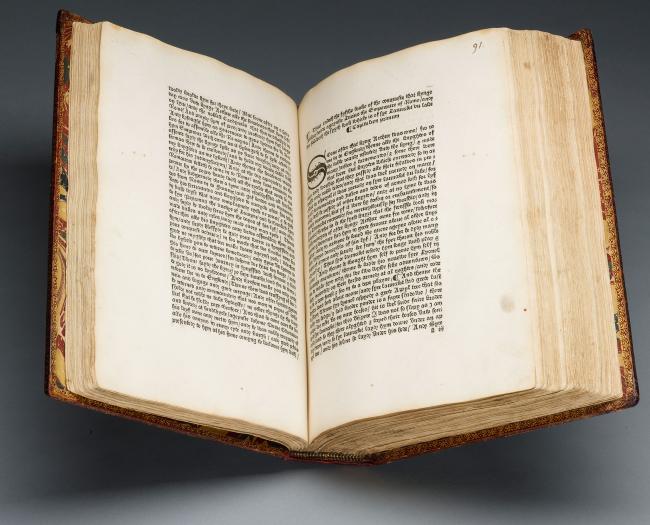
William Caxton (ca. 1422-1491/92) was a merchant, diplomat, translator, author, and publisher. With an eye toward commercial opportunity, he learned the new technology of typographical printing while in Cologne, Germany and focused on the untapped market of English texts for English readers, becoming the first printer in London (Westminster) by about 1476. Caxton published more than one hundred titles ranging from works of English literature to religious and historical texts. He helped to stabilize the English language by choosing to print in only one of the multiple dialects in use at the time; through print this dialect became more widespread and helped to form the basis of modern English. The Morgan has one of the largest collections of Caxton imprints in the world, collected for their literary, linguistic, and historical importance. J. Pierpont Morgan favored Caxton over Johann Gutenberg as a founder of printing and chose to memorialize him in the ceiling of the East Room.
One of Caxton's most ambitious publications was Sir Thomas Malory's great epic of Arthur and the Knights of the Round Table. Malory based his text almost solely upon the older French Lancelot-Grail cycle, which he translated while in Newgate Prison between 1460 and 1470. Despite its size (this edition is over 860 pages), some consider Le morte d'Arthur to be the first English novel. It is perhaps the most significant work of English literature between Geoffrey Chaucer and William Shakespeare, and it forms the basis of all modern Arthurian legends and stories. Caxton's printed edition bears no decoration, with even the initials beginning each chapter printed in black, which suggests that it was not intended for an elite audience who would pay extra for painted initials. This was a more affordable book for a more general audience. Only two copies of this edition survive (the Morgan's copy being the only complete copy), and its rarity suggests that copies were read until they fell apart and had to be replaced.
Author, title, and imprint from colophon (leaf ee6r): Thus endeth thys noble and joyous book entytled le morte Darthur/ Notwuthstondyng it treateth of the byrth/ lyf/ and actes of the sayd kyng Arthur/ of his noble knyghtes of the rounde table/ theyr mervayllous enquestes and adventures/ thachyevyng of the sangreal/ [et] in thende the dolorous deth [et] departyng out of thys wolde of them al/ which book was reduced in to englysshe by syr Thomas Malory knyght as afore is sayd/ and by me devuded in to xxi bookes chapytred and enprynted / and fynysshed in thabbey westmestre the last day of Juyl the yere of our lord /M/CCCC/lxxxv/. Caxton me fieri fecit.
Printed in Caxton's type 4:95B.
Collation: [1]⁸ [2]¹⁰; a-z, [et], A-Z, aa-dd⁸ ee⁶: 432 leaves, leaf [1]/1 blank. First quire with leaves 2, 3, and 4 so signed; second quire with leaves 1, 2, 3, and 4 signed as 5, 6, 7, and 8.
Paper format: Chancery folio
Only other known copy at the John Rylands Library, University of Manchester, missing 10 leaves replaced in facsimile.
For an account of the paper stocks in this edition, see BMC XI 321 and the Scolar Press facsimile of this copy, pp. 10-32.
PML copy leaf dimensions: 28.6 x 20.8 cm.
PML copy missing 1 leaf: [1]/1 (blank).
PML copy reproduced in facsimile: Scolar Press, 1976, with an introduction by Paul Needham.
Le morte Darthur
Hand decoration: Rubrication not required. Annotations: 1 marginal notation in text: "honor," in crayon, 16/17th century (leaf T5r). Black ink smudges/fingerprints sporadically throughout. Modern foliation up to 130.
Watermark: page 6. Hand with sleeve cuff.
Watermark: page 9. Shield with diagonal straps inside.
Watermark: page 15. Shield with diagonal straps inside.
Watermark: page 10. Dog with collar.
Watermark: page 70. Scissor centered on chain line.
Watermark: page 77. Hand with five-pointed star.
[Historiae Romanae decades].

Title from ISTC.
Colophon (leaf [42]/12v): .M.CCCC.LXX. Proderat haud multum Livi abs te scripta fuisse / Maxima si romȩ facta pari eloquio: / Q[ue] seu desidiis: alio seu crimine quovis: / Sive & temporibus cuncta fere occiderant: Queq[ue] superfuerant opera: hec tam rara videri: / Ut pene ipsorum copia nulla for[et]: / Et Vindelino debebis tu qoqu[ue]: formis / Egregie impressit has modo qui decadas: Atq[ue] ipsas iisdem scevis velut hostibus acri / Bellow oppugnatas fortiter eripuit. ...
Printed in type 1:110R.
Collation: [Dec. I: 1-2¹²; 3-11¹⁰ 12¹⁰(1+1 bella opti[m]e) 13-15¹⁰ 16-17⁸; Dec. II: 18-24¹⁰; Dec. III: 25-31¹⁰; Dec. IV: 32-34¹⁰ 35-36⁸ 37-41¹⁰ 42¹⁴]: 421 leaves, leaves [1]/1, [17]/8, and [42]/14 blank.
Paper format: Royal folio
Edited by Johannes Andreas, bishop of Aleria.
The outer sheet of quire [c] was reprinted to include a portion of text omitted from the original printing (BMC).
A copy is known (formerly in the collection of W.H. Crawford, sold at Sotheby's 12 March 1891, lot 1905, again 30 Nov. 1995, lot 280) with a colophon date 1469, which is an eighteenth-century forgery: see M. Castellana in Bulletin du bibliophile et du bibliothécaire 1891, confirmed by more recent observation.
PML copy leaf dimensions: 40 x 26.8 cm.
PML copy bound in two volumes (I: quires [1-17], II: quires [18-42])--each volume has different decoration and annotations.
PML copy missing 2 leaves: [1]/1 and [17]/8 (blanks) and with a blank leaf (probably [42]/14) bound before quire [32] in vol. II.
Vol. I (PML 278). Hand decoration: Illuminated white vine initial; rubricated, alternating red and blue lombards. Annotations: Contemporary marginal notations (in quires [1]-[7]) and alpha-numeric manuscript quire signatures.
Vol. II (PML 279). Hand decoration: Pen and wash historiated initials on blue ground, bas-de-page borders in the style of Girolamo da Cremona; rubrics added in red and blue before each Decade, in red before each book. Annotations: No marginal notations in text.
[Opera].

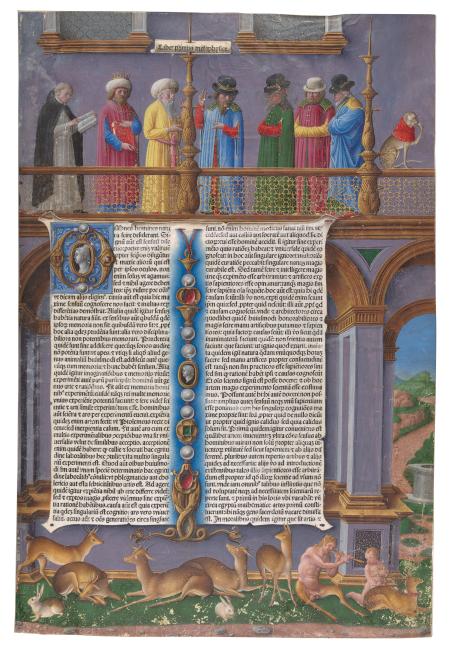
Title from ISTC.
Issued in 8 parts, dated: I.1) for Johannes de Colonia, 1 Feb. 1483; I.2) 2 Oct. 1483; II.1.1) 27 May 1483; II.1.2) 25 Sept. 1483; II.2.1) 12 Sept. 1483; II.2.2) 8 Oct. 1483; III.1) 25 Oct. 1483; III.2) for Johannes de Colonia, 3 Feb. 1483.
Printed in types 3:74G and 8:93G.
Collation: Vol. I, part 1 (Organon, or Isagoge): a-b⁶ c⁴ d¹⁰ e⁶ f¹⁰ g-k⁶ l⁸ m⁶ n⁸ o-p⁶ q¹⁰ ⁸: 118 leaves; Vol. I, part 2 (Physica): AA-UU⁸: 160 leaves; Vol. II, part 1 (De caelo et mundo): a-h⁸; aa-dd⁸ ee⁶ ff⁸ gg¹⁰: 120 leaves; Vol. II, part 2 (De anima and De sensu et sensato etc.): A¹⁰ B-F⁸ G-H⁶ I-L⁸ M-N⁶: 98 leaves; Vol. III, part 1 (Metaphysica): [1]⁴; 1-12⁸ 13¹⁰ 14⁸ 15⁸ 16⁶: 132 leaves; Vol. III, part 2 (Ethica ad Nicomachum, Politica, and Oeconomica): A-C⁶ CC⁸ D-Q⁶: 104 leaves.
Paper format: Royal folio
Commentary by Averroës.
Edited by Nicoletus Vernia.
PML copy on vellum.
PML copy leaf dimensions: vol. I: 40.9 x 27 cm. and vol. II: 41 x 28 cm.
PML copy bound in 2 volumes. Vol. I bound: (Physica) AA-UU⁸; (De caelo et mundo) a-h⁸; aa-dd⁸ ee⁶ ff⁸ gg¹⁰; (Meteorologica from De anima) L⁸ M-N⁶; (De anima) A¹⁰ B-F⁸ G-H⁶ I-K⁸; (Vernias's preface to Metaphysica) [1]⁴. Vol. II bound: (Metaphysica) 1-12⁸ 13¹⁰ 14⁸ 15⁸ 16⁶; (Ethica etc.) A-C⁶ CC⁸ D-Q⁶; (Organon) a-b⁶ c⁴ d¹⁰ e⁶ f¹⁰ g-k⁶ l⁸ m⁶ n⁸ o-p⁶ q¹⁰ ⁸.
PML copy missing 9 leaves: leaves q10 (I.1), UU8 (I.2), a1 (II.1), ee6 (II.1), gg10 (II.1), A1 (II.2), H6 (II.2), N6 (II.2) and [1]/1 (III.1).
Hand decoration: Illuminated frontispieces by Girolamo da Cremona (leaves AA2r (Physica) and 1/1r (Metaphysica)); illuminated frontispiece (leaf a1r (Porphyry)), illuminated and penwork initials by Benedetto Bordon; illuminated initials by Antonio Maria della Villafora; penwork decoration on minor initials in 3 hands (unidentified hand, Bordon, and Villafora), some undecorated or unrealized, alternating red and blue paragraph marks. Unfinished initials: vol. I, leaf I5v and vol. II, leaf d2r. Annotations: No marginal notations in either volume.
[Views of Sezincote House and grounds, the Seat of Sir Charles Cockerell].

The artist Thomas Daniell (1749–1840) introduced architectural elements from India into the English garden on the basis of scenery and monuments he had sketched in the course of a ten-year tour of the Subcontinent. When Sir Charles Cockerell, a "nabob" made wealthy by three decades with the East India Company, built a new house at Sezincote in a fusion of Hindu and Mogul styles, Daniell transformed a part of the garden into a dream of India in the Cotswolds, with a shrine to the Hindu sun god beside a lotus-shaped pool with sacral fountain. The temple housed a figure of Surya cast in Coade & Seeley's Patent Imitation Stone.
Consists of 10 hand colored aquatints, printed in sepia.
Title from RLG record: QMCA87-B20653 and from Ray.
Suggested date publication from Ray.
Sir Charles Cockerell employed Martin to create the portfolio of views of Sezincote House in 1817; the plates were subsequently issued privately in a limited number of sets. Cf. Ray.
Individual plates lettered below image: Drawn & etched by J. Martin ... Engraved by F.C. Lewis.
Views of Sezincot House
John Martin

View of the Temple of Suryah & Fountain of Maha Dao, with a Distant View of North Side of Mansion House
Etching with aquatint added by Frederick Christian Lewis (1779–1856), in Martin's series of views of Sezincote, ca. 1818.
Bequest of Gordon N. Ray, 1987
The artist Thomas Daniell (1749–1840) introduced architectural elements from India into the English garden on the basis of scenery and monuments he had sketched in the course of a ten-year tour of the Subcontinent. When Sir Charles Cockerell, a "nabob" made wealthy by three decades with the East India Company, built a new house at Sezincote in a fusion of Hindu and Mogul styles, Daniell transformed a part of the garden into a dream of India in the Cotswolds, with a shrine to the Hindu sun god beside a lotus-shaped pool with sacral fountain. The temple housed a figure of Surya cast in Coade & Seeley's Patent Imitation Stone.
Noël Le Mire
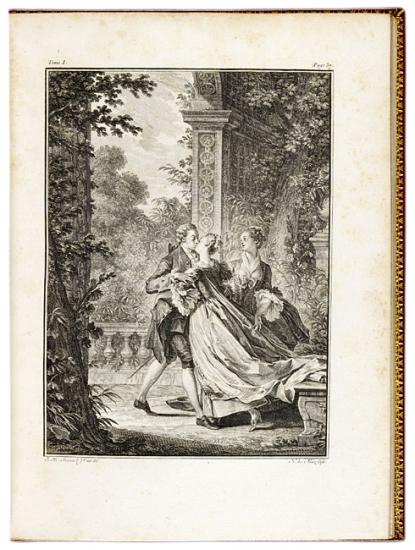
[Le premier baiser de l'amour.]
Engraving and etching, part of a suite of plates made for Collection complète des oeuvres de J. J. Rousseau.
Brussels: Jean-Louis de Boubers, 1774–83.
Bequest of Gordon N. Ray, 1987
Julie, accompanied by her cousin, grants a first kiss to her lover in a bosquet, or bower. This memorable scene was a favorite of the novel's illustrators, beginning with Hubert François Gravelot, who received detailed instructions from Rousseau on how to achieve just the right combination of innocence and sensuality. And yet his composition seems staid in comparison to this version by Moreau le Jeune, who admired Rousseau's works and had studied them closely. Moreau understood what kind of bower the author had in mind, not the neatly trimmed trellis imagined by Gravelot but rather this grand arch overgrown by trees, shrubbery, and flowers.
James Charles Armytage

Lake, Land, and Cloud
Frontispiece in vol. 3 of Ruskin's Modern Painters: Their Superiority in the Art of Landscape Painting to All the Ancient Masters Proved by Examples of the True, the Beautiful, and the Intellectual, from the Works of Modern Artists, Especially from those of J. M.W. Turner.
London: Smith, Elder and Co., 1843–60. 5 vols.
Bequest of Gordon N. Ray, 1987
Modern Painters began as a counterattack on critics of the landscape paintings of J. M. W. Turner but grew into a magisterial treatise on art theory and aesthetics, containing stinging social commentary as well as salient observations on literature, philosophy, and religion. Ruskin's ideas greatly influenced the work of Victorian garden designers, such as William Robinson and Gertrude Jekyll in England and Andrew Jackson Downing in America. The engraved frontispiece reproduces a Ruskin drawing, an ideal landscape in the Turnerian style.
Verscheyde soorten van gedierten

Verscheyde soorten van gedierten
Haarlem: Margareta van Bancken..., 1690
Purchased on the Ball Fund, 1985
Cesare Vecellio
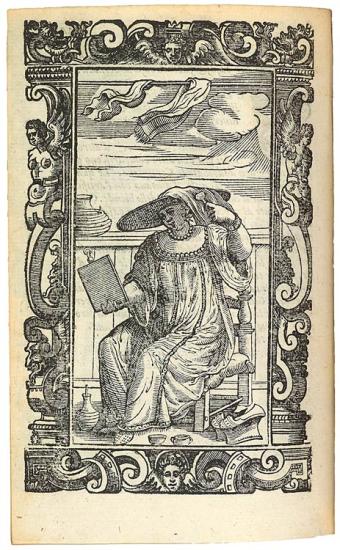
Degli habiti, antichi et moderni di diversi parti del mondo (Of Costumes, Ancient and Modern, of Different Parts of the World)
Printed by Damian Zenaro in Venice, 1590
Opening: Woman Blonding Her Hair
Purchased with the Toovey Collection, 1899


One of the most timeless and eloquent of historical documents, the Declaration of Independence stands with the Magna Carta, as a classic charter of freedom. The document is a formal statement by the representatives of the Thirteen Colonies announcing their separation from Great Britain and the birth of the United States of America. The Morgan's copy is one of just twenty-five recorded copies of the first printing of the Declaration and is considered one of the two or three finest in existence.
The text was drafted by Thomas Jefferson and approved by the Continental Congress on July 4, 1776. On that day, it was resolved that an accurate copy should be printed and distributed to "the several Assemblies, Conventions & Committees or Councils of Safety and to the several Commanding Officers of the Continental troops." A few weeks later, fifty-six delegates to the Continental Congress signed a slightly but significantly different version of this text, which was engrossed on parchment and is now on display at The National Archives.
The Morgan's copy of the Declaration came into the hands of Benjamin Chew (1722-1810), who, until the Revolution, was chief justice of Pennsylvania. It was preserved as part of the Chew family archives in Cliveden, their country house in Germantown. The Morgan purchased it at auction in New York in 1982.